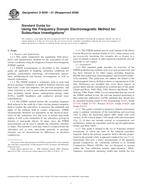Potrebujeme váš súhlas na využitie jednotlivých dát, aby sa vám okrem iného mohli ukazovať informácie týkajúce sa vašich záujmov. Súhlas udelíte kliknutím na tlačidlo „OK“.
ASTM D4700-15
Standard Guide for Soil Sampling from the Vadose Zone (Withdrawn 2024)
Automaticky preložený názov:
Štandardné príručka pre pôdy Odber vzoriek z Vados zóny
NORMA vydaná dňa 1.2.2015
Informácie o norme:
Označenie normy: ASTM D4700-15
Poznámka: NEPLATNÁ
Dátum vydania normy: 1.2.2015
Kód tovaru: NS-583309
Počet strán: 16
Približná hmotnosť: 48 g (0.11 libier)
Krajina: Americká technická norma
Kategória: Technické normy ASTM
Kategórie - podobné normy:
Anotácia textu normy ASTM D4700-15 :
Keywords:
ICS Number Code 07.060 (Geology. Meteorology. Hydrology)
Doplňujúce informácie
| Significance and Use | ||||||||||||||||||||||||||||||||||
|
5.1 Chemical analyses of liquids, solids, and gases from the vadose zone can provide information on the presence, possible source, migration route, and physical-chemical behavior of contaminants. Remedial or mitigating measures can be formulated based on this information. This guide describes devices and procedures that can be used to obtain vadose zone soil samples. 5.2 Soil sampling is useful for the reasons presented in Section 1. However, it should be recognized that the general method is destructive, and that resampling at an exact location is not possible. Therefore, if a long term monitoring program is being designed; other methods for obtaining samples should be considered. Note 1: The quality of the result produced by this standard is
dependent on the competence of the personnel performing it, and the
suitability of the equipment and facilities used. Agencies that
meet the criteria of Practice D3740 are generally considered capable of
competent and objective testing/sampling/inspection/etc. Users of
this standard are cautioned that compliance with Practice
D3740 does not in itself
ensure reliable results. Reliable results depend on many factors;
Practice D3740 provides a
means of evaluating some of those factors
|
||||||||||||||||||||||||||||||||||
| 1. Scope | ||||||||||||||||||||||||||||||||||
|
1.1 This guide covers procedures that may be used for obtaining soil samples from the vadose zone (unsaturated zone). Samples can be collected for a variety of reasons including the following: 1.1.1 Stratigraphic description, 1.1.2 Hydraulic conductivity testing, 1.1.3 Moisture content measurement, 1.1.4 Moisture release curve construction, 1.1.5 Geotechnical testing, 1.1.6 Soil gas analyses, 1.1.7 Microorganism extraction, 1.1.8 Pore liquid evaluation, or 1.1.9 Laboratory chemical analysis identifying contaminant types and concentrations within soils. 1.2 Guides D6169 on Selection of Soil and Rock Sampling Devices and D6282 on Drilling methods for Environmental Site Characterization provide subsequent supplemental information to the contents of this standard. 1.2.1 Direct Push Soil Sampling (Guide D6282) and Sonic Drilling for Site Characterization (Practice D6914) are used extensively for environmental soil sampling in the Vadose zone. 1.2.1.1 Subsurface explorations are documented in accordance with D5434 on Logging of Subsurface Explorations. (1) Soil core may require processing using Practice D6640 on Collection and Handling of Soil Cores for Environmental Explorations. 1.3 This guide focuses on methods that provide soil samples for chemical analyses of the soil or contained liquids or contaminants. However, comments on how methods may be modified for other objectives are included. 1.4 This guide does not describe sampling methods for lithified deposits and rocks (for example, sandstone, shale, tuff, granite). 1.5 In general, it is prudent to perform all field work with at least two people present. This increases safety and facilitates efficient data collection. 1.6 The values stated in inch-pound units are to be regarded as standard. The values given in parentheses are mathematical conversions to SI units that are provided for information only and are not considered standard. 1.7 This standard does not purport to address all of the safety concerns, if any, associated with its use. It is the responsibility of the user of this standard to establish appropriate safety and health practices and determine the applicability of regulatory limitations prior to use. 1.8 This guide offers an organized collection of information or a series of options and does not recommend a specific course of action. This document cannot replace education or experience and should be used in conjunction with professional judgment. Not all aspects of this guide may be applicable in all circumstances. This ASTM standard is not intended to represent or replace the standard of care by which the adequacy of a given professional service must be judged, nor should this document be applied without consideration of a project's many unique aspects. The word “Standard” in the title of this document means only that the document has been approved through the ASTM consensus process. |
||||||||||||||||||||||||||||||||||
| 2. Referenced Documents | ||||||||||||||||||||||||||||||||||
|
Podobné normy:
Historická
1.5.2010
Historická
15.9.2008
Historická
1.12.2008
Historická
1.7.2007
Historická
1.7.2007
Historická
1.5.2010



 ASTM D6431-99(2010)..
ASTM D6431-99(2010).. ASTM D6527-00(2008)..
ASTM D6527-00(2008).. ASTM D6639-01(2008)..
ASTM D6639-01(2008).. ASTM D6726-01(2007)..
ASTM D6726-01(2007).. ASTM D6727-01(2007)..
ASTM D6727-01(2007).. ASTM D7128-05(2010)..
ASTM D7128-05(2010)..
 Cookies
Cookies
